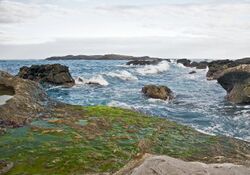Viridiplantae
| Viridiplantae | |
|---|---|

| |
| An assortment of thallophyte Viridiplantae in a rock pool, Taiwan | |
| Scientific classification | |
| Domain: | Eukaryota |
| Clade: | Diaphoretickes |
| (unranked): | Archaeplastida |
| (unranked): | Viridiplantae Cavalier-Smith, 1981 |
| Subgroups | |
| |
| Synonyms | |
| |
Viridiplantae (literally "green plants")[5] are a clade of eukaryotic organisms made up of the green algae, which are primarily aquatic, and the land plants (embryophytes), which emerged within them.[6][7][8] Green algae traditionally excludes the land plants, rendering them a paraphyletic group. Since the realization that the embryophytes emerged from within the green algae, some authors are starting to include them.[9][10][11][12][13] They have cells with cellulose in their cell walls, and primary chloroplasts derived from endosymbiosis with cyanobacteria that contain chlorophylls a and b and lack phycobilins. More than 350,000 species of Viridiplantae exist.[14]
In some classification systems, the group has been treated as a kingdom,[15] under various names, e.g. Viridiplantae, Chlorobionta, or simply Plantae, the latter expanding the traditional plant kingdom to include the green algae. Adl et al., who produced a classification for all eukaryotes in 2005, introduced the name Chloroplastida for this group, reflecting the group having primary chloroplasts with green chlorophyll. They rejected the name Viridiplantae on the grounds that some of the species are not plants, as understood traditionally.[16] The Viridiplantae are made up of two clades: Chlorophyta and Streptophyta as well as the basal Mesostigmatophyceae and Chlorokybophyceae.[17][18] Together with Rhodophyta and glaucophytes, Viridiplantae are thought to belong to a larger clade called Archaeplastida or Primoplantae.
A taxonomic evaluation of eukaryotes based on myosin distribution showed the Viridiplantae lost class-I myosins.[19]
Phylogeny and classification
Leliaert et al. 2012
Simplified phylogeny of the Viridiplantae, according to Leliaert et al. 2012.[20]
- Viridiplantae
-
- core chlorophytes
- prasinophytes (paraphyletic)
-
- Mesostigmatophyceae
- Chlorokybophyceae
- Klebsormidiophyceae
- Charophyceae
- Zygnematophyceae
- Coleochaetophyceae
- Embryophyta (land plants)
Cladogram
Below is a consensus reconstruction of green algal relationships, mainly based on molecular data.[22][20][21][23][11][24][25][18][26]
| Viridiplantae/ |
| ||||||||||||||||||||||||||||||||||||||||||||||||||||||||||||||||||||||||||||||||||||||||||||||||||||||||||||||||||||||||||||||
| Green Algae |
References
- ↑ "The kingdoms of organisms". Quart. Rev. Biol. 13: 383–420. 1938.
- ↑ The Classification of Lower Organisms. Palo Alto: Pacific Books. 1956. p. 6. https://archive.org/details/classificationof00cope.
- ↑ "New concepts of kingdoms or organisms. Evolutionary relations are better represented by new classifications than by the traditional two kingdoms" (PDF). Science 163 (3863): 150–60. January 1969. doi:10.1126/science.163.3863.150. PMID 5762760. http://www.ib.usp.br/inter/0410113/downloads/Whittaker_1969.pdf.
- ↑ (in German) Einführung in die Phykologie. Stuttgart: Georg Thieme Verlag. 1978. https://books.google.com/books?id=tfkmAAAAMAAJ&dq.
- ↑ 5.0 5.1 "Eukaryote kingdoms: seven or nine?". Bio Systems 14 (3-4): 461–81. 1981. doi:10.1016/0303-2647(81)90050-2. PMID 7337818.
- ↑ "Gain and loss of elongation factor genes in green algae". BMC Evolutionary Biology 9: 39. February 2009. doi:10.1186/1471-2148-9-39. PMID 19216746.
- ↑ "Function and evolution of the vacuolar compartment in green algae and land plants (Viridiplantae)". International Review of Cytology. International Review of Cytology 264: 1–24. 2007. doi:10.1016/S0074-7696(07)64001-7. ISBN 9780123742636. PMID 17964920.
- ↑ Redfield, Rosemary Jeanne, ed (July 2008). "EEF2 analysis challenges the monophyly of Archaeplastida and Chromalveolata". PLOS One 3 (7): e2621. doi:10.1371/journal.pone.0002621. PMID 18612431.
- ↑ "Plants". Current Biology 21 (11): R417-22. June 2011. doi:10.1016/j.cub.2011.04.021. PMID 21640897.
- ↑ "Charophycean Green Algae Home Page". http://www.life.umd.edu/labs/delwiche/Charophyte.html.
- ↑ 11.0 11.1 "From algae to angiosperms-inferring the phylogeny of green plants (Viridiplantae) from 360 plastid genomes". BMC Evolutionary Biology 14: 23. February 2014. doi:10.1186/1471-2148-14-23. PMID 24533922.
- ↑ "The Evolutionary Origin of a Terrestrial Flora". Current Biology 25 (19): R899-910. October 2015. doi:10.1016/j.cub.2015.08.029. PMID 26439353.
- ↑ "Estimating the timing of early eukaryotic diversification with multigene molecular clocks". Proceedings of the National Academy of Sciences of the United States of America 108 (33): 13624–9. August 2011. doi:10.1073/pnas.1110633108. PMID 21810989.
- ↑ "Mega-phylogeny approach for comparative biology: an alternative to supertree and supermatrix approaches". BMC Evolutionary Biology 9: 37. February 2009. doi:10.1186/1471-2148-9-37. PMID 19210768.
- ↑ "Viridiplantae". https://www.uniprot.org/taxonomy/33090.
- ↑ "The new higher level classification of eukaryotes with emphasis on the taxonomy of protists". The Journal of Eukaryotic Microbiology 52 (5): 399–451. 2005. doi:10.1111/j.1550-7408.2005.00053.x. PMID 16248873.
- ↑ "EST analysis of the scaly green flagellate Mesostigma viride (Streptophyta): implications for the evolution of green plants (Viridiplantae)". BMC Plant Biology 6: 2. February 2006. doi:10.1186/1471-2229-6-2. PMID 16476162.
- ↑ 18.0 18.1 "Early photosynthetic eukaryotes inhabited low-salinity habitats". Proceedings of the National Academy of Sciences of the United States of America 114 (37): E7737-E7745. September 2017. doi:10.1073/pnas.1620089114. PMID 28808007.
- ↑ "Drawing the tree of eukaryotic life based on the analysis of 2,269 manually annotated myosins from 328 species". Genome Biology 8 (9): R196. 2007. doi:10.1186/gb-2007-8-9-r196. PMID 17877792.
- ↑ 20.0 20.1 "Phylogeny and molecular evolution of the green algae" (PDF). Critical Reviews in Plant Sciences 31: 1–46. 2012. doi:10.1080/07352689.2011.615705. http://images.algaebase.org/pdf/5628E58F0ecc431F0CsJm2B04CAD/49951.pdf.
- ↑ 21.0 21.1 "Nested in the Chlorellales or independent class? Phylogeny and classification of the Pedinophyceae (Viridiplantae) revealed by molecular phylogenetic analyses of complete nuclear and plastid-encoded rRNA operons". Protist 163 (5): 778–805. September 2012. doi:10.1016/j.protis.2011.11.004. PMID 22192529.
- ↑ "Green algae and the origin of land plants". American Journal of Botany 91 (10): 1535–56. October 2004. doi:10.3732/ajb.91.10.1535. PMID 21652308. http://www.amjbot.org/cgi/content/full/91/10/1535.
- ↑ "Origin of land plants revisited in the light of sequence contamination and missing data". Current Biology 22 (15): R593-4. August 2012. doi:10.1016/j.cub.2012.06.013. PMID 22877776.
- ↑ "Chloroplast phylogenomic analyses reveal the deepest-branching lineage of the Chlorophyta, Palmophyllophyceae class. nov". Scientific Reports 6: 25367. May 2016. doi:10.1038/srep25367. PMID 27157793. PMC 4860620. http://www.nature.com/articles/srep25367.
- ↑ "The revised classification of eukaryotes". The Journal of Eukaryotic Microbiology 59 (5): 429–93. September 2012. doi:10.1111/j.1550-7408.2012.00644.x. PMID 23020233. PMC 3483872. http://onlinelibrary.wiley.com/doi/10.1111/j.1550-7408.2012.00644.x/abstract.
- ↑ "Plastid phylogenomic analysis of green plants: A billion years of evolutionary history". American Journal of Botany 105 (3): 291–301. March 2018. doi:10.1002/ajb2.1048. PMID 29603143. http://doi.wiley.com/10.1002/ajb2.1048.
Wikidata ☰ Q11973077 entry

